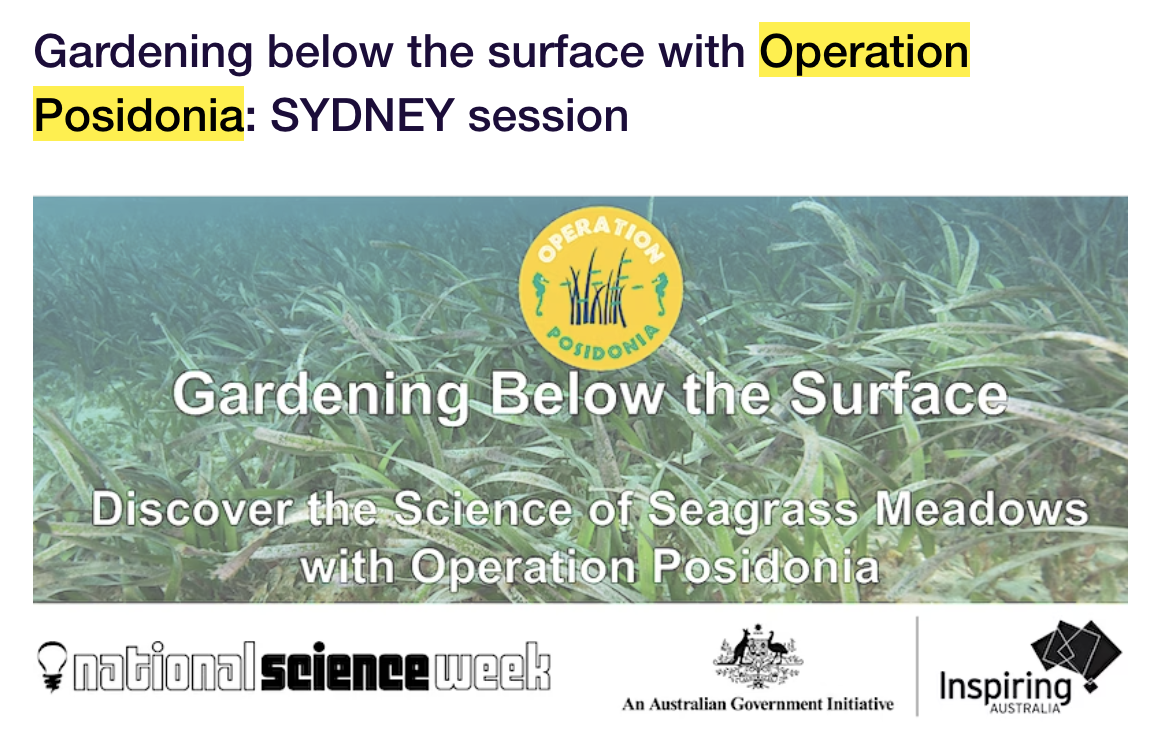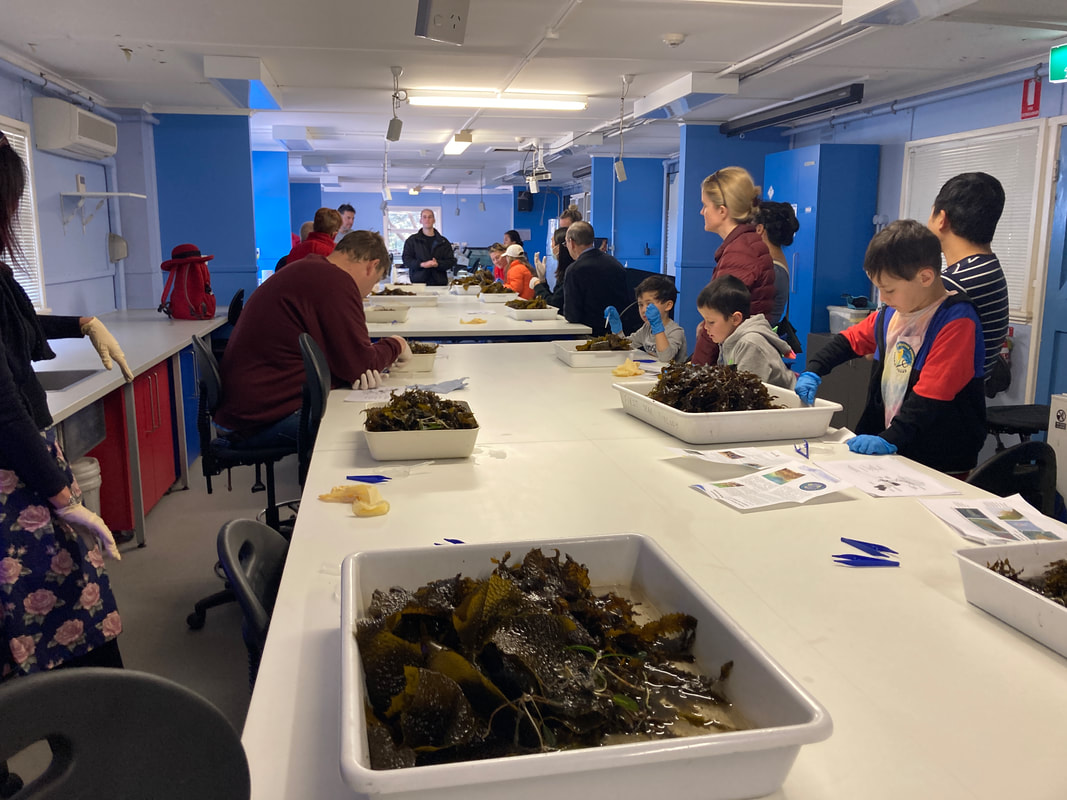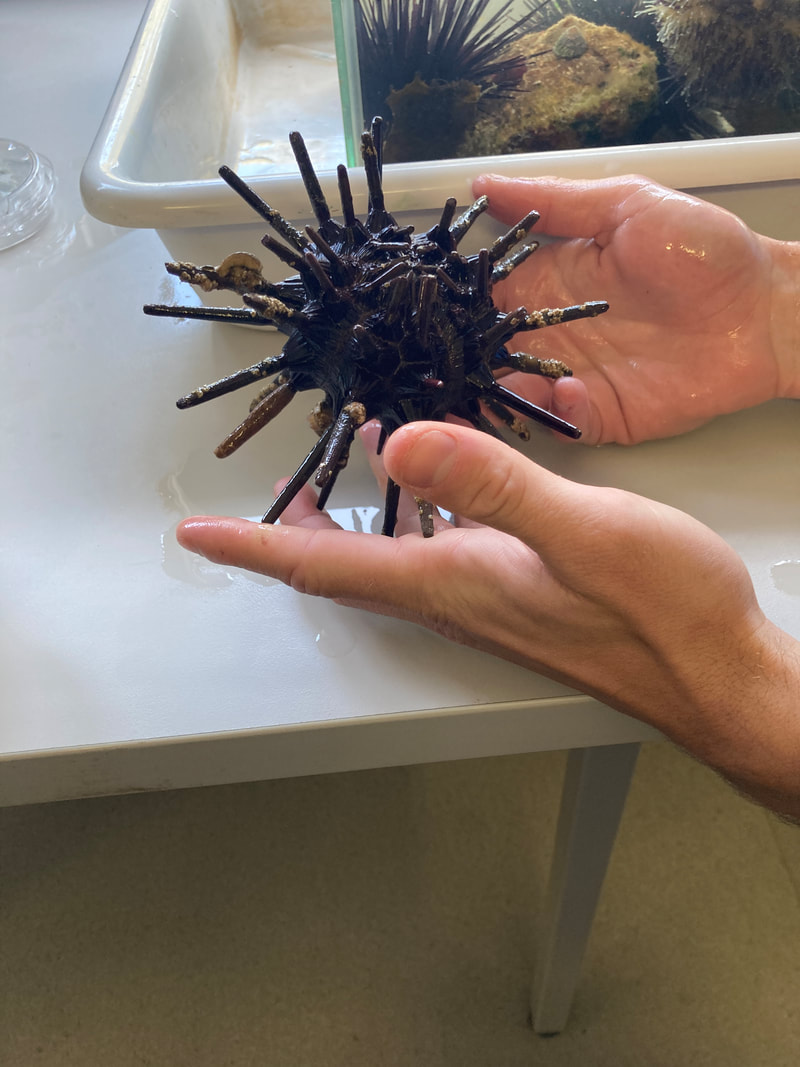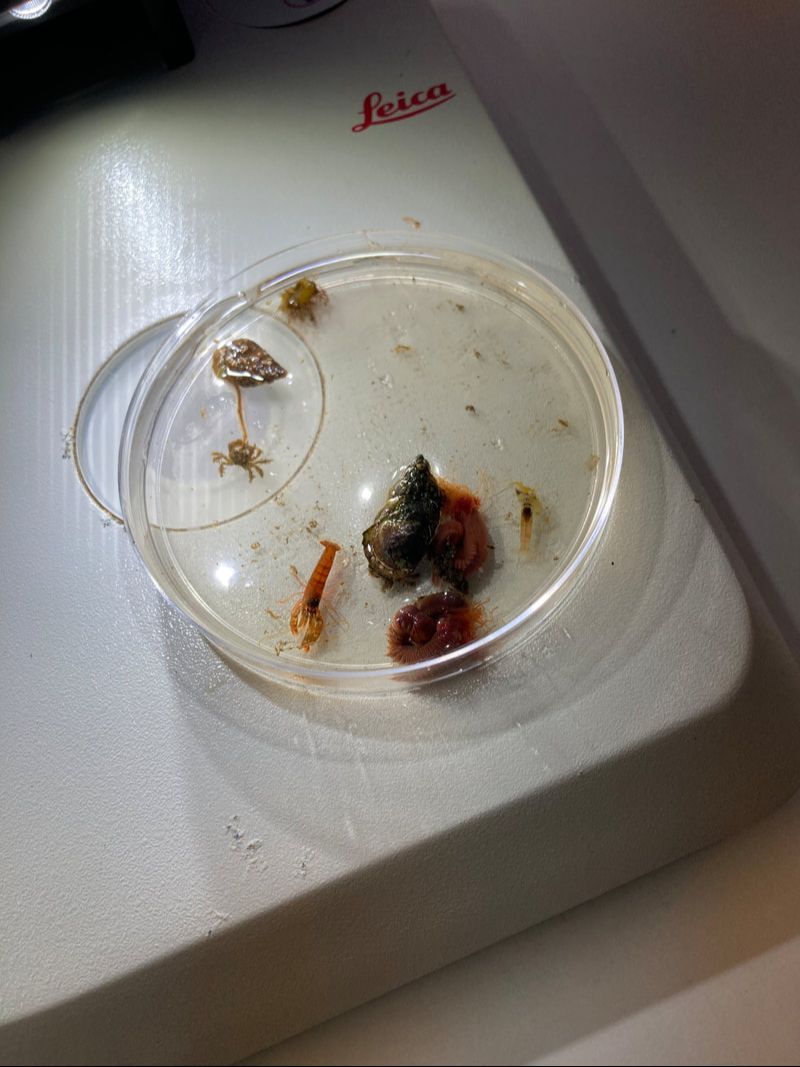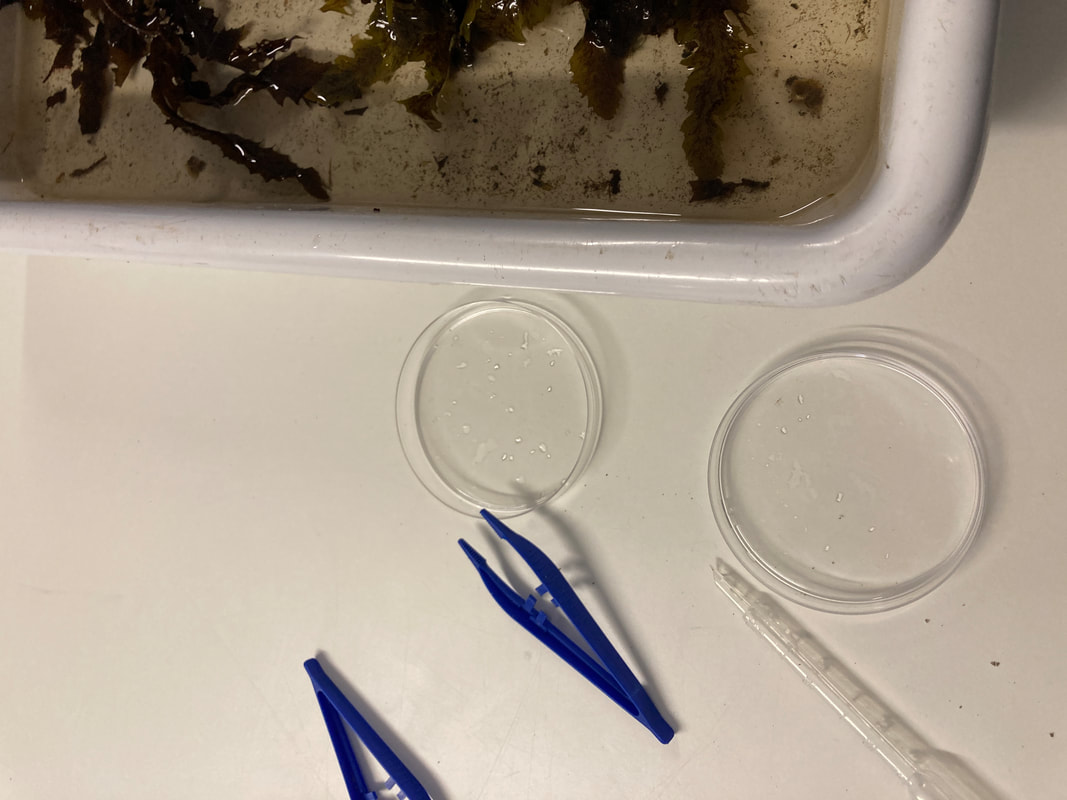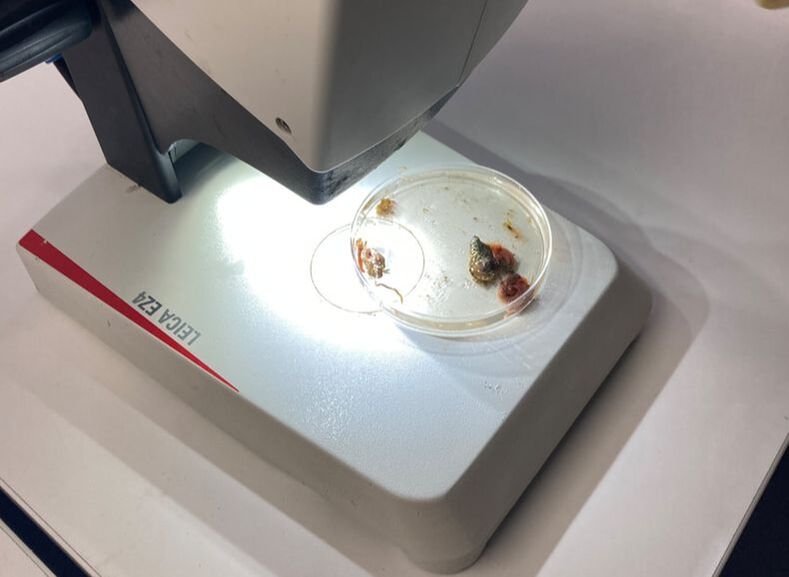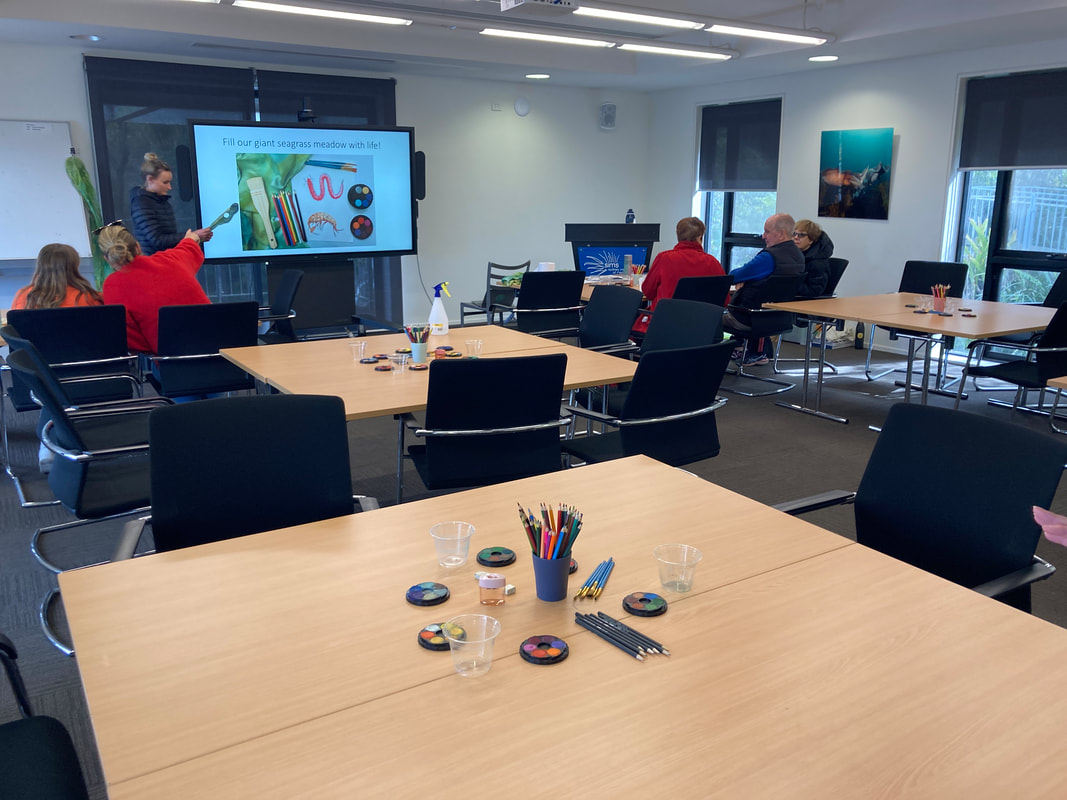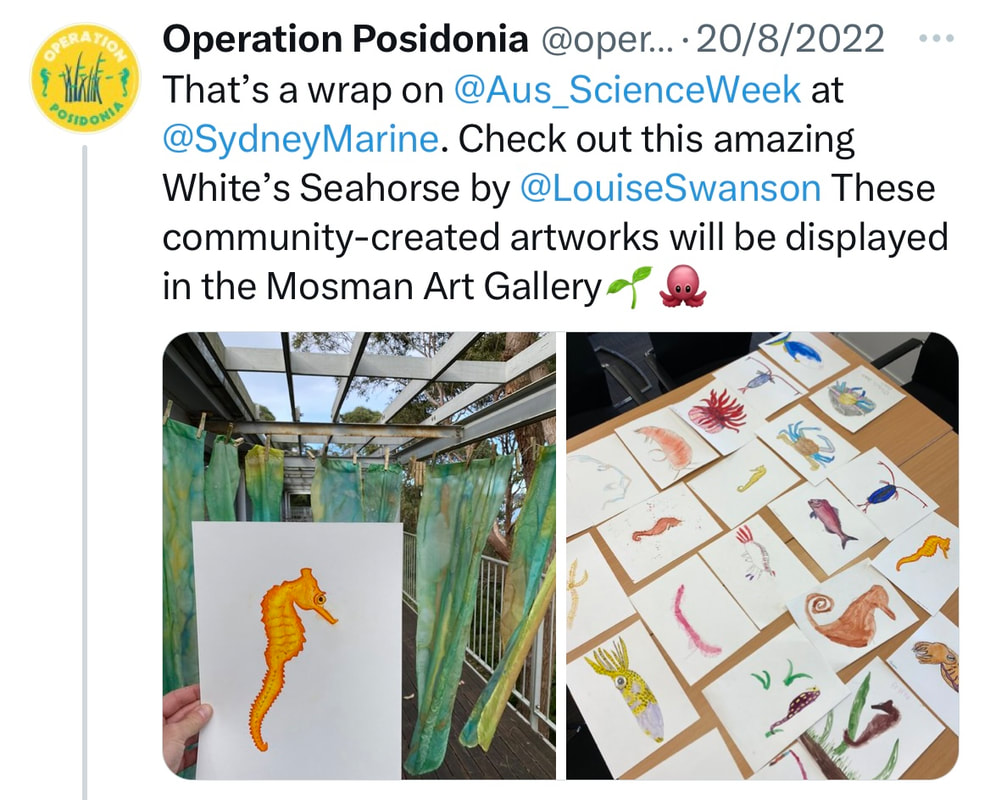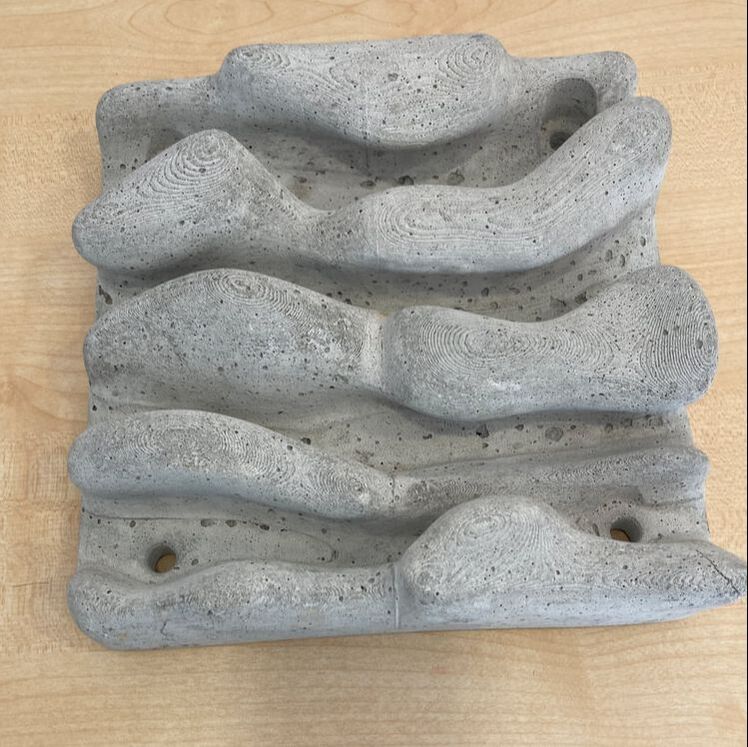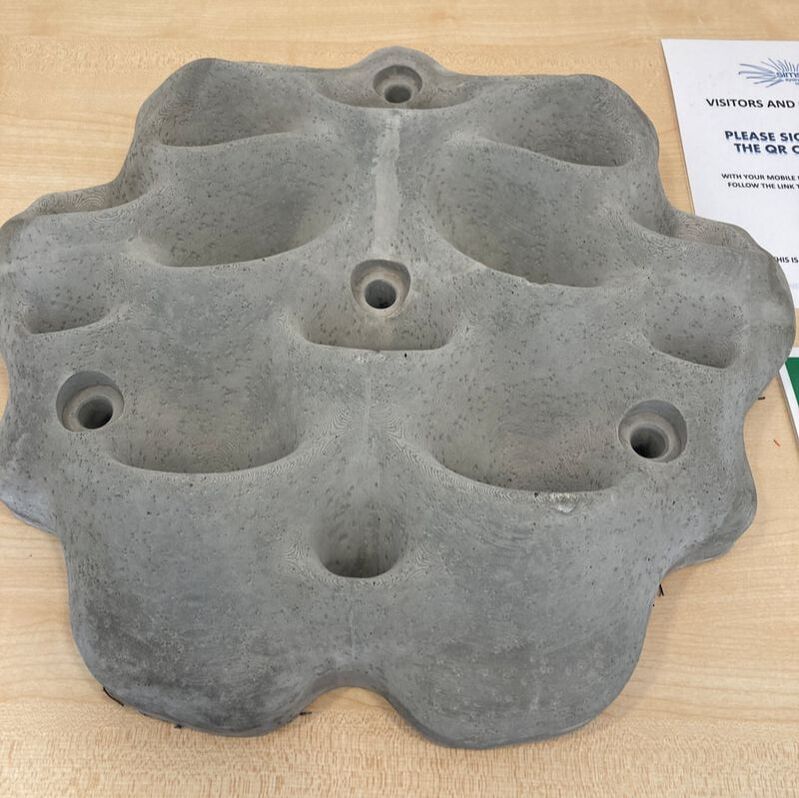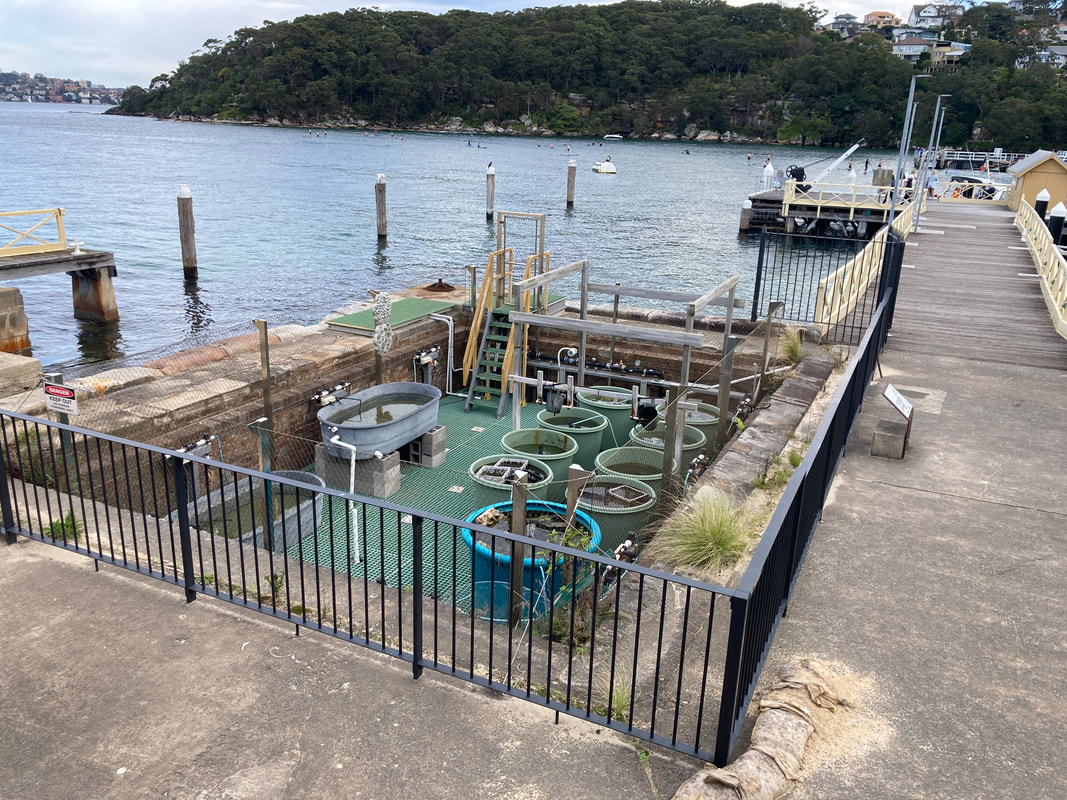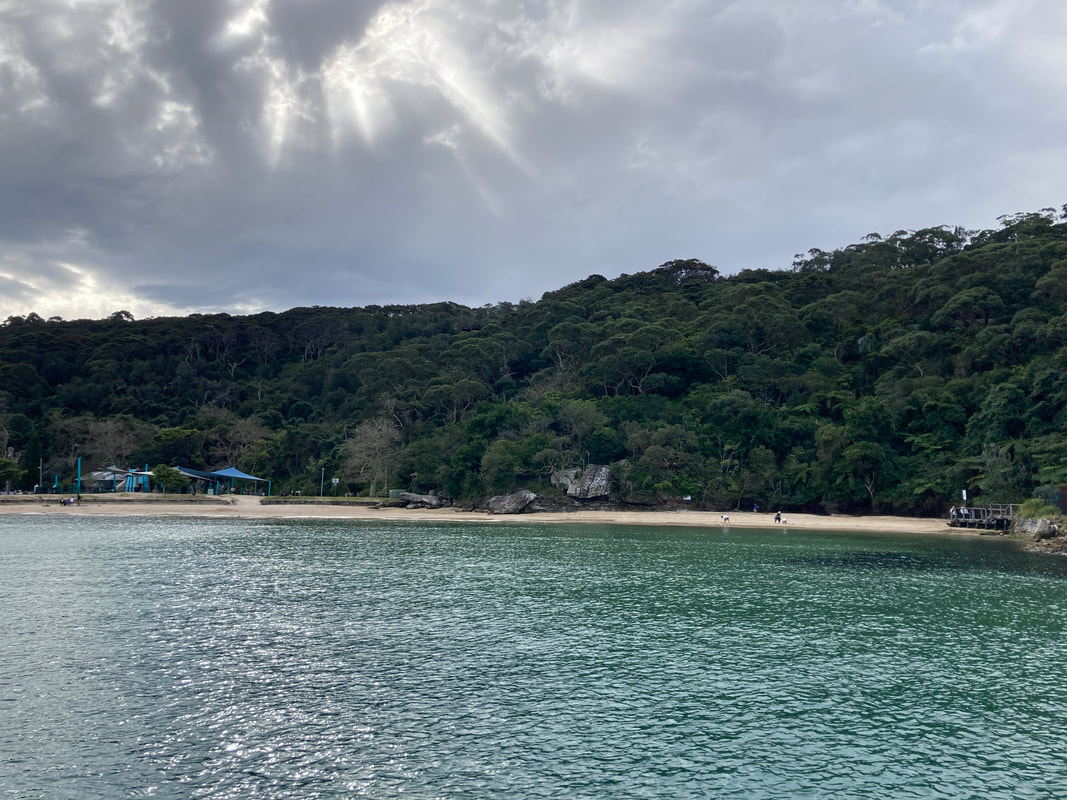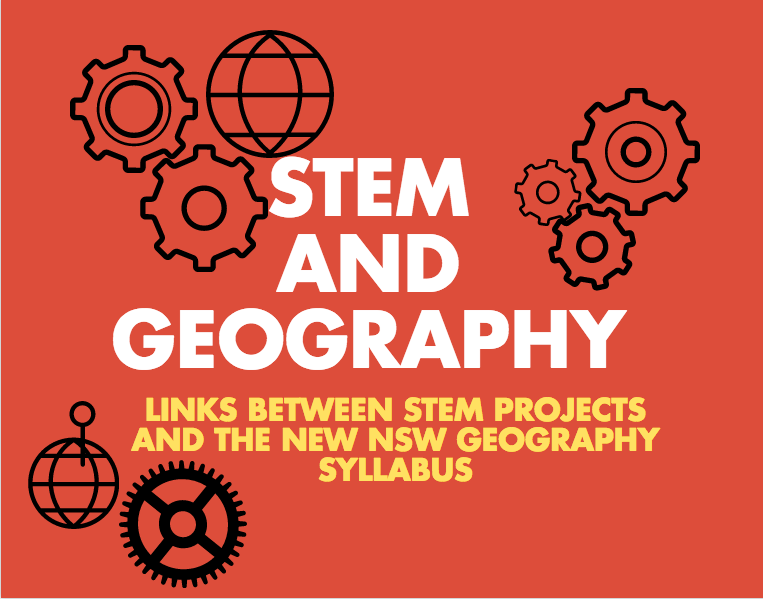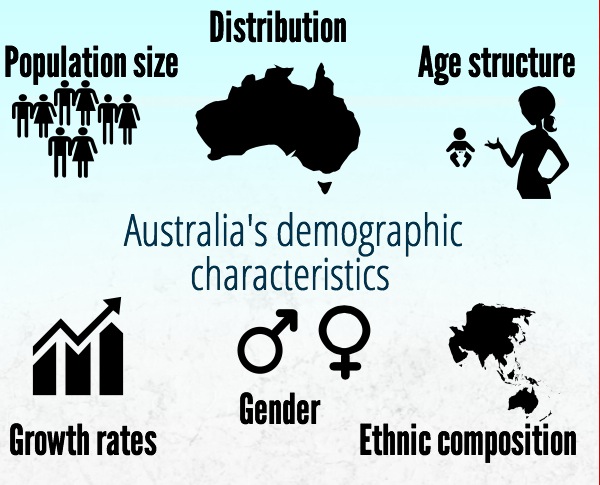|
As part of National Science Week, the Sydney Institute of Marine Science (SIMS) held sessions to raise public awareness about the fragile nature of seagrass meadows. Although this event was promoted as a Science event, it had clear links to the Geography syllabus - both the Year 10 Environmental Change and Management topic and the Year 9 - Biomes topic. SIMS is located on Chowder Bay Rd, Mosman. The session involved examining specimens form nearby Chowder Bay/Clifton Gardens, a tour of classroom facilities and a display of seawall panel designs. As information on the Great Southern Reef becomes more readily available, some of these activities would tie in really well with this case study of Geography classes. Seagrass and seaweed - there was a collection aquatic organisms which could be identified using a field chart and also facilities to exam them under the microscope Part of the day involved an art project to promote public awareness about seagrass. The artworks were transferred onto silks that had been dyed to represent seagrass. This became part of an installation at Mosman Art Gallery. You can read more about the art project here: https://www.lissfinney.com/public-projects There was also a display of seawall panels designed by Living Seawalls. These panels are designed to be adhered to seawalls to encourage biodiversity. The crevices are intended to encourage aquatic species to use the structure as habitat. You can read about Living Seawalls here: https://www.livingseawalls.com.au/ There is a testing area where the Living Seawall panels are being tested in Chowder Bay. The shark nets at this site are also a common place for snorkelers to find seahorses.
I'm definitely coming back for a closer look. This is one of several posts about our Balmain Foreshore Project. Read more... Balmain Foreshore Project - Introduction Gardening Below the Surface - Operation Posidonia Balmain Foreshore Project - Trial Activities Balmain Foreshore Project - Implementation Balmain Foreshore Project - Living Seawalls Balmain Foreshore Project - Living Seawalls: Pre-Installation Biodiversity Survey
0 Comments
I attended the Department of Education’s STEM Showcase (see the tweet feed at #STEMShowcase). In case you’ve been living under a rock – STEM is Science, Technology, Engineering and Maths. STEM is clearly a movement that is gaining momentum, and my question is where does geography fit into this? Or History? Or Commerce? I have been trying to think of a new acronym to get us in on this movement. If you have any ideas, please let me know. What occurred to me is how many of these STEM projects have very obvious crossovers with humanities subjects, particularly geography. This post will look at a few of the presentations that I saw today and some ideas of how humanities subjects could also be included.
Baulkham Hills High School – Weather TECH Students created a STEM project involving the construction of a weather station. This involved a design process, coding of the equipment, manufacturing the equipment with a 3D printer, and collecting and analysing weather data. In the Science faculty, this was undertaken as part of a student research project. In TAS, students developed skills in using CAD and CAM software and Arduino to design, code and create the equipment. In Maths, students' skills were developed in analysing and presenting the vast amount of weather data collected. Students (and teachers) successfully created a working model with equipment collecting weather data every second. The real world applications to agriculture were emphasised. In the new NSW Geography syllabus the WeatherTECH project would fit easily within the Water In the World topic, particularly Water resources and the Water cycle. It also addresses fieldwork requirements – using weather instruments. Examine the WeatherTECH project site. Bellingen High School - Survive the Shake The topic of this STEM project was earthquake proof buildings. Students designed, produced and evaluated a multi-storey building with a small fooprint, which was specified. Students were provided with a design process to follow which provided a scaffold to follow during project. Students were required to use cheap materials such as straws, toothpicks, marshmallows, etc to create a model of their buildings. Building designs were tested on an earthquake shake table created by the teachers. In the Science faculty, the project tied into content related to earthquake size and magnitude, damage and destruction and prediction of quakes. In Maths it tied in with content related to geometry, 3D design shapes and budgets. The construction of the buildings and the design process involved the TAS faculty. In the new NSW Geography syllabus the Survive the Shake project would fit into Landforms and Landscapes, particularly Geomorphic hazards. This could easily incorporate the inquiry based learning skills in the syllabus. Examine the Survive the Shake project site. Riverside Girls High – Post-Earth Survival The girls at Riverside completed a STEM project examining the requirements to sustain life. Students explored the universe and designed a colony suitable for sustaining life on another planet. Students focused on: What do humans need to survive? The project used a design process from the TAS faculty and this was used to determine project milestones. TAS introduced the students to the tools they would need to complete the project such as Sketch Up, 3D printing, etc. Students brainstormed what it would be like if they were locked inside their house and had to stay there for 2-3 years. What would they need? What would they have to change? Students collected data on energy and water use in their own homes. From a Maths perspective students had to develop problem solving and reasoning skills, as well as data analysis. The project also incorporated the EcoMuve program from Harvard University. Assessment and presentation involved peer review and feedback. In the new NSW syllabus the Post-Earth Survival project would fit into Place and Liveability, particularly Influences and perceptions. This could also incorporate the inquiry based learning skills in the syllabus. Examine the Post-Earth Survival project site. Promoting Geography and boosting numbers A lot of time, effort and money is being spent on promoting STEM to our students. As Geography teachers, we are constantly looking for ways to promote our subject and boost senior numbers. There are plenty of ways to do this, but I think getting involved in STEM projects or at least other cross curriculum projects might be one idea that is worth a bit more consideration. BOSTES announced today that the new Elective 7-10 Geography syllabus is to be implemented in 2017. The remainder of this year is for familiarisation and planning.
Similarly to the new 7-10 Geography syllabus incorporating the Australian curriculum, it includes the Learning Across the Curriculum areas as well as the key geographical concepts of place, space, interconnections, environment, scale, sustainability and change. It includes a concepts continuum outlining which aspects of each concept should be covered in each stage. The geographical inquiry skills continuum and geographical tools continuum have also been included. The Elective course provides opportunity of geographical inquiry. The Stage statements for both Stage 4 and 5 have a whole paragraph emphasising the importance of geographical inquiry. There is an emphasis on problematic knowledge, with students required to investigate challenges, collect primary and secondary data, propose solutions and actions. Students are also required to investigate challenges from a range of different perspectives. Several of the topics allow for the exploration of an investigative study. Interestingly the Elective course is focused almost solely on outcomes and content. The Mandatory Geography course also has inquiry questions to guide each topic and a content focus, neither of which are present in the Elective syllabus. The topics in the new Elective Geography course are: - Physical Geography - Primary Production - Australia's Neighbours - Interactions and Patterns Along a Transcontinental Transect - Oceanography - Global Citizenship - Political Geography - School-developed Option A Life Skills course has been provided as part of the Elective course which aligns with topics of the mainstream course. This will make it manageable for teachers to deliver the Life Skills course within a mainstream classroom. Information is provided on reporting and to guide assessment in both the mainstream and Life Skills course. The syllabus and support documentation can be found on BOSTES: http://www.boardofstudies.nsw.edu.au/syllabus_sc/geography.html BOSTES (formerly the Board of Studies) has recently released the new NSW Geography syllabus for review. This syllabus, unique to NSW, incorporates the Australian Curriculum for Geography already being implemented in other states in Australia.
The draft new syllabus can be found at the BOSTES website along with documents outlining the features of the documents for different groups (Primary, K-10, Life Skills). The draft document does not include a Senior Geography syllabus draft at this stage. The consultation session will only run until August 29, 2014, so it is a fairly brief period. There are a number of opportunities for people to become involved: Individual responses to BOSTES There is an online survey which can be filled in, which is fairly comprehensive but contains closed questions. The survey covers topics such as views on the rationale, aims, topics, whether current resources can be used, whether it caters for a full range of students, etc. You can also make more detailed written submissions which can be emailed directly to the Senior Project Officer, Geography, Brooke Prideaux (email available at the BOSTES page linked above). BOSTES sessions: A number of sessions have been organised by BOSTES during the consultation period. These are to be held at Liverpool, Pennant Hills, Gymea and Ashfield as well as regional sessions at Moruya, Coffs Harbour, Orange and Griffith. Each of these sessions require registration very soon. Check the above-linked BOSTES page for details and links to registration. This is being organised by Eventbrite, but I'm sure that Brooke would the any questions. DEC sessions: For teachers in NSW Public Schools, the DEC Learning and Leadership Directorate are holding consultation sessions to put together a submission on behalf of the DEC. This will be done using Adobe Connect, and registration should be completed through the DEC's Professional Learning database and management system MyPL. The title is "Secondary consultation on the draft Geography K-10 Syllabus" (Course Code: NR06641). This is to take place on Monday 28 July 3.30pm – 4:30 pm. Alana Ellis, the Relieving HSIE Advisor 7-12 is the contact person, and can be contacted through her DEC email. Professional Associations and informal groups: Interestingly, the NSWGTA Annual Conference falls mid way through the consultation period. I suspect that while there doesn't appear to be a consultation session on the agenda (the agenda was released before the draft syllabus) that there may be some slight rearranging of the program to allow time for it. Online groups, such as Geography Teachers Online Australia (Facebook group) are already abuzz with discussions regarding various parts of the new syllabus. This is a great way to hear a few different perspectives and get involved in the debate. Faculties Don't forget that sometimes the best discussions can happen face to face in your own faculty. Consider what the difficulties are of the current syllabus for your students. Will the new syllabus solve these problems? Are there new issues? How will your students cope with the content? Will they find it interesting? What resources do you currently use that will fit in with new syllabus? What are the areas that are going to need a lot of work? What we already know: - Australia already has an agreed Australian Curriculum for Geography. The writing of the curriculum was completed in 2012, involved consultation between states, with professional associations and teachers, and was signed off by federal and state education ministers. There have been no discussions or public announcements about a review of this curriculum at this stage, despite reviews currently taking place of other subjects. - All states/territories but NSW began implementation of the Australian Curriculum for Geography in 2013. Like the Phase 1 subjects (English, Maths, Science, History), BOSTES decided that the structure of the Australian Curriculum was not suitable for NSW teachers, and that it would need to be rewritten to more closely resemble the current/previous syllabi. - BOSTES appointed a Project Manager to oversee the writing of the Geography syllabus for NSW as of January 2014. The former BOS had a procedure for writing new syllabi which involved hiring a team of writers, consulting with stakeholders, reviewing and refining. We can assume that a similar process was followed and that this has taken place between January and July to allow for the new document to be released. - While we are in a consultation period, we can assume that some sections of the syllabus are "locked in" while other parts are open to discussion. These have been labelled in the draft document. Please make sure you take the opportunity to have your say while we have the chance. I was lucky enough to attend the first ever TM Geography a couple of weeks ago. The teachmeet was held at Saint Ignatius' College on Monday 5 and was hosted by Jessica Lonard. Using infographics in assessment Jessica Lonard, our host, began the presentations with a presentation on how to use infographics in assessment of student learning. The room was decorated with examples of her students' work. There are a range of programs that can be used to create these infographics. One of the easiest is Picktochart. Other programs include Infogr.am, visual.ly, and easel.ly. For further information you might like to check out 10 free tools for creating infographics. Spotlight - ABS Sharon McLean presented a session on Spotlight from the Australian Bureau of Statistics which I have discussed in a previous blog: Australia's Population. This program brings population statistics about Australia to life by presenting them in a fun interactive voiced by Shaun Micallef. Flipping the geography classroom Ryan Gill presented a session about the challenges and successes of flipping his classroom including creating the videos, winning over parents and keeping students engaged. Flipping the classroom is a strategy where students are exposed to new material outside of the classroom through the use of videos, readings, etc and then class time is used to consolidate the new learning through activities such as discussions, problem solving and debates. Google Tour builder Mick Law from Contour Education showed us the latest and greatest mapping tools, concentrating mainly on the new Google Tour Builder. This seems to be a much simpler way to create a virtual tour than through Google Earth. Nearpod Kate Corcoran showed us how she uses Nearpod in her classroom. Nearpod is a program that allows you to set up interactive quizzes and surveys and enables sharing between groups. Students log into a group and can access the resources that the teacher has made available to them on their devices. The teacher can control the students' screen while they are part of the group. Thinglink Thinglink is a site which enables you to create interactive images. Di Laycock showed us how you can add comments, images, videos and music to create a multimedia experience from a still image. Creating virtual field sites
I went through the process of creating a virtual field site to give students access to field sites which they would not otherwise be able to experience. This is done by combining videos, photos, google tours, and links to articles all combined with the use of a blog site or website builder like weebly. Twitter: #tmgeography It can be hard to make statistics about the Australia's population interesting and engaging. I like to think of Geography as a hands-on subject where students can get outside and learn about the world, and for me examining statistics just doesn't do it for me. A couple of ideas to make it a little more engaging are: - students conducting class surveys on some of the characteristics explored in the census, - teaming up with a sister school through Skype or other forms of videoconferencing and exploring the similarities and differences within your classrooms, towns and regions. This would work best if comparing an urban and regional school. - supporting the information about the statistics by examining similar data in visual forms such as infographics. The Australian Bureau of Statistics has made learning all these facts and figures much more interesting in the past couple of years by creating ABS Spotlight and Run That Town.
ABS Spotlight is an online, interactive activity which asks students to input some basic information about themselves and compares this information with the rest of Australia's population. It has been built using Flash so it works best on PC, but they have also created a non-Flash version which is slightly less interactive and visual, so it will also work on iPads. Run That Town operates in a similar way to games like Sim City in that students make planning decisions based on information that is provided throughout the running of the game. Students can examine census information, newspaper articles, assess development proposals for the town of their choice. The real innovation with this game is that students are accessing real data about a real suburb or town within Australia. This is a great example of blurring the lines between game-based learning and real-life application of knowledge. The game can be accessed through the Apple's App store. They have also released ABS Mobile an app available for Ios devices (iPhone, iPad and iPod). You are able to access the most up to date census data on suburbs. If Australia Were 100 People is another smaller interactive resource from the ABS based around health statistics. It is quite short (around a minute or so), but it might still be worth exploring. There is also a great PowerPoint from a GTANSW presentation by Pat Beeson on different resources from the ABS and ideas on how to deliver the information. You can also find a range of lesson activities from the ABS in the Education Services section. For more infographics and student resources visit the Communities section of the www.9Geography.hsieteachers.com site. |
Categories
All
Archives
May 2024
|
